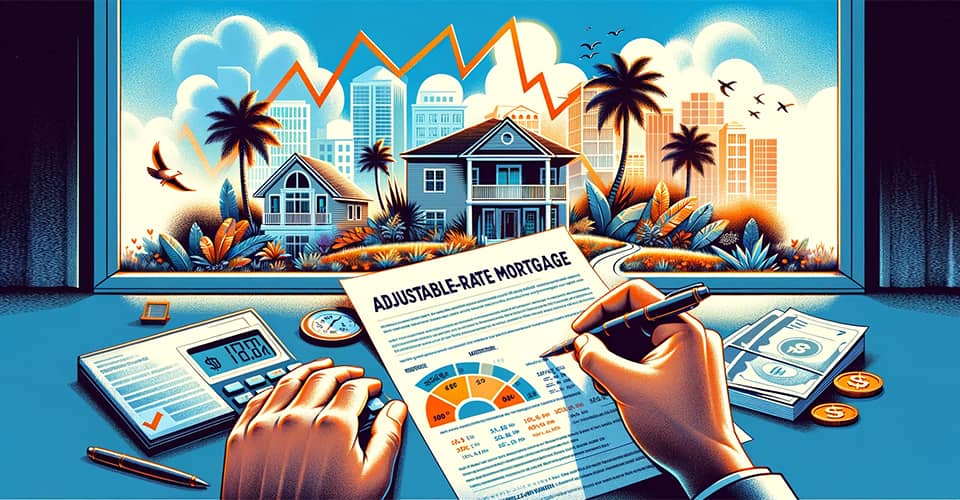Comparison of ARM Mortgage Rates: FHA, VA, Conventional
Adjustable-Rate Mortgages (ARMs) are a type of home loan where the interest rate can change, which might help you save money at the start.
They're a good choice if you want a lower rate early on and are okay with it changing later based on the economy. But, it's important to know how ARMs work, including the parts that make up your rate and how it can go up or down.
This guide is here to explain everything about ARMs, from getting qualified to understanding how different agencies look at these loans, making it easier for you to figure out if an ARM is right for you.
Table of Contents
- Adjustable-Rate Mortgages: An Overview
- How To Qualify For An Adjustable-Rate Mortgage?
- Fannie Mae Vs. Freddie Mac ARM Guidelines
- FHA ARM Guidelines
- VA ARM Guidelines
- Understanding ARM Initial Fixed-Rate Periods
- What Does Note Rate Plus Life Cap Mean For ARMs?
- How Are ARM Qualifying Rates Calculated?
- Agency Guidelines
- Bottom Line
Adjustable-Rate Mortgages: An Overview
Adjustable-rate mortgages (ARMs) are home loans with interest rates that can change periodically, based on an index that reflects the cost to the lender of borrowing on the credit markets.
The initial interest rate of an ARM is often lower than that of a fixed-rate mortgage, making it an attractive option for homebuyers looking to minimize initial payments.
However, since the rate can increase or decrease at predetermined intervals, ARMs carry a certain degree of financial unpredictability over the long term.
Key components of an ARM include the index, margin, interest rate caps, and the initial fixed-rate period, which determine how and when the interest rate will adjust.
Understanding these elements is crucial for borrowers to assess an ARM's risks and benefits and choose a loan that best fits their financial situation.

How To Qualify For An Adjustable-Rate Mortgage?
To qualify for an Adjustable-Rate Mortgage (ARM), borrowers must navigate a set of criteria that evaluate their financial stability and the potential for future rate adjustments.
Lenders assess the borrower's credit score, employment history, and debt-to-income ratio to ensure they can handle potential increases in the interest rate.
Requirements to qualify for an ARM include:
Credit Score
-
Conventional (Fannie Mae/Freddie Mac): Typically requires a minimum credit score of 620.
-
FHA: Minimum credit score of 580 for a 3.5% down payment or 500-579 for a 10% down payment.
- VA: No minimum credit score requirement set by the VA, but lenders usually require a score of 620 or higher.
Employment History and Debt-to-Income Ratio
Stable employment, typically two years in the same job or field. DTI is a ratio that lenders use to assess a borrower's ability to manage monthly payments and repay debts.
Additionally, if you are getting an adjustable-rate mortgage, you should understand the following:
-
Initial Interest Rate: Understanding the loan's starting rate and how it compares to standard mortgage rates.
-
Fully Indexed Rate: Awareness of the loan's potential maximum rate, considering the index and margin.
- Initial Fixed-Rate Period: The duration of the initial rate before it adjusts, affecting the qualifying rate and loan strategy.
Fannie Mae Vs. Freddie Mac ARM Guidelines
When you're looking at Adjustable-Rate Mortgages (ARMs) from Fannie Mae and Freddie Mac, here's what you need to know in simple terms:
Fixed-Rate Periods
Both offer loans with a period where your rate won't change, like for 3, 5, 7, or 10 years. The length of this period affects your starting rate.
How They Decide Your Rate
Fannie Mae
If your fixed-rate period is short (5 years or less), your loan's rate is based on a formula that includes the loan's initial rate and possibly a future rate. If it's longer, you might qualify using just the initial rate.
Freddie Mac
Works similarly, using a formula that considers the loan's initial rate and future rates to decide what you qualify for, depending on the length of your fixed-rate period.
Both have rules that limit how much your interest rate can increase when it's time for adjustments, which helps protect you from sudden large increases.
Fannie Mae and Freddie Mac use a mix of your loan's initial and potential future rates to determine if you qualify. They also cap how much your rate can go up, which is good for planning your finances.
Whether you choose Fannie Mae or Freddie Mac, you get an ARM with protection like rate caps. The main difference is in how they calculate the rate you qualify for, which can depend on how long before your rate starts changing.
FHA ARM Guidelines
When looking into an FHA Adjustable-Rate Mortgage (ARM), here’s a straightforward breakdown:
Starting Rate Stability
FHA ARMs have an initial period where your interest rate stays the same, for example, 1, 3, or 5 years. This period helps you plan your budget with a predictable payment at the start.
Determining Your Qualifying Rate
For Short Initial Periods
If your fixed-rate period is really short, like one year, the FHA considers both your starting rate and a slightly higher rate to decide if you qualify. This is to ensure you can handle a rate increase in the near future.
For Longer Initial Periods
For ARMs with a longer fixed-rate start, like 3 or 5 years, you might qualify based on the initial interest rate, making it simpler to get approved.
FHA limits the amount your rate can increase when it adjusts. This cap protects you from big jumps in your monthly payment.
FHA ARMs start with a period of stable payments. How you qualify might involve looking at your starting rate and a projected future rate, especially for short-term fixed rates. But there’s a safety net with caps on how high your rate can increase over time.
With an FHA ARM, you can start with stable payments. The FHA checks to ensure you can handle future increases, and they cap those increases to protect you.
VA ARM Guidelines
For veterans looking at VA Adjustable-Rate Mortgages (ARMs), here’s what you need to know in clear terms:
Initial Rate Guarantee
VA ARMs offer a period of time during which your interest rate won't change. This could be for 1, 3, 5, or more years, giving you predictable payments at the start.
How Your Rate is Set
The VA focuses on your current situation, ensuring the initial rate is manageable. Unlike other loan types, the VA doesn’t focus heavily on future potential rates for qualification purposes. This approach can make it easier for veterans to qualify for a loan.
Like other ARMs, VA loans have caps. These caps limit how much your interest rate can increase at each adjustment period and over the life of the loan, protecting you from drastic changes in your monthly payments.
With a VA ARM, you get a fixed initial rate, making your early loan payments predictable. The VA provides a straightforward path to qualification, focusing more on the present than predicting future rates. And you’re protected from steep rate increases with caps.
VA ARMs offer stability and predictability with an initial fixed rate and protect veterans with caps on rate increases. The VA's qualification process is designed to be accessible, focusing on providing immediate, manageable payments for veterans.
Understanding ARM Initial Fixed-Rate Periods And Their Impact On Qualifying Rates
When you get an Adjustable-Rate Mortgage (ARM), the initial fixed-rate period is the first phase where your interest rate stays constant.
This can last for 1, 3, 5, 7, or 10 years, directly influencing your monthly payments and how you budget. Your payments are predictable during this time, offering stability as you adjust to your new home expenses.
The length of this period also affects the interest rate you initially qualify for; shorter periods might offer lower starting rates, but anticipate increases later. On the other hand, longer fixed-rate periods provide more rate stability but may start a bit higher.
This period is crucial in planning your financial future and deciding which ARM best fits your needs. Understanding the initial fixed-rate period helps you make an informed decision, balancing the desire for lower initial payments and payment stability over time.
What Does Note Rate Plus Life Cap Mean For ARMs?
The "life cap" refers to the maximum amount your interest rate can increase in total over the entire term of the loan from the initial rate you were given.
For example, if your starting note rate is 3% and your loan has a life cap of 5%, the highest your interest rate could ever go, regardless of market fluctuations, is 8%.
This concept is crucial for borrowers because it offers protection against extreme increases in interest rates over the life of the loan.
It provides a clear ceiling on how high your interest payments could go, helping you assess your ARM's long-term affordability.
Understanding the note rate plus life cap is essential for managing potential risks and planning your financial future when considering an adjustable-rate mortgage.
How Are ARM Qualifying Rates Calculated For Different Fixed-Rate Periods?
The calculation of ARM (Adjustable-Rate Mortgage) qualifying rates varies depending on the length of the initial fixed-rate period. This period is crucial because it determines the starting point for when the mortgage rate will begin to adjust.
Here’s a simplified explanation of how these rates are typically calculated for different fixed-rate periods:
For ARMs with shorter initial fixed periods, like 1 to 3 years, lenders often use a higher qualifying rate to ensure borrowers can afford the mortgage if rates increase.
This qualifying rate could be the sum of the initial note rate plus a specified margin, or it might be based on the fully indexed rate, which is the index rate plus the lender's margin at the time of loan origination.
The qualifying rate calculation can be a bit more lenient for longer fixed-rate periods, such as 5, 7, or 10 years, often allowing borrowers to qualify at the note rate.
This is because the risk of rate increases is delayed, providing more stability to the borrower's financial situation in the loan's early years.
Agency Guidelines For Adjustable-Rate Mortgage Qualification
Navigating the qualification process for an Adjustable-Rate Mortgage (ARM) involves understanding the diverse guidelines set forth by various lending agencies.
These agencies, including FHA, VA, Fannie Mae, and Freddie Mac, each have unique criteria for assessing a borrower's eligibility for an ARM.
The overarching goal is to ensure borrowers can handle potential fluctuations in their mortgage payments as interest rates change.
FHA guidelines typically require a lower minimum credit score than conventional loans and consider the potential for rate increases by using a qualifying rate that may include a buffer above the initial rate.
This approach helps ensure borrowers can afford their payments even if rates rise.
VA loans, designed for veterans and service members, offer ARMs with features like no down payment and no minimum credit score requirement set by the VA, though lenders might have their criteria.
The VA focuses on the ability to pay and uses the initial note rate for qualification, providing a stable entry point for borrowers.
Fannie Mae and Freddie Mac, which are the backbones of most U.S. home loans, have specific formulas that determine the qualifying rate for ARMs.
These might involve the note rate plus a certain percentage of the fully indexed rate, considering the longer-term perspective of rate adjustments.
Understanding these agency guidelines is crucial for borrowers considering an ARM.
It allows them to assess which type of loan best matches their financial situation and how they can prepare for the future, considering the potential for rate increases and their impact on monthly mortgage payments.
Each agency's guidelines are designed to ensure borrowers are qualified at the outset and remain capable of managing their loans as rates adjust over time.
Bottom Line
ARMs can offer significant advantages, but they come with their own set of complexities and considerations.
From understanding the initial fixed-rate period and its impact on your payments to navigating the specific qualifying criteria set forth by agencies like FHA, VA, Fannie Mae, and Freddie Mac, it’s important to go into this process armed with information.
Knowing how your rate can change over time, including the implications of the note rate plus life cap, will help you make an informed decision that aligns with your long-term financial goals.
If you're considering an ARM and looking for guidance tailored to your situation, MakeFloridaYourHome is here to help you confidently navigate the journey to homeownership.
With over 50 years of mortgage industry experience, we are here to help you achieve the American dream of owning a home. We strive to provide the best education before, during, and after you buy a home. Our advice is based on experience with Phil Ganz and Team closing over One billion dollars and helping countless families.

About Author - Phil Ganz
Phil Ganz has over 20+ years of experience in the residential financing space. With over a billion dollars of funded loans, Phil helps homebuyers configure the perfect mortgage plan. Whether it's your first home, a complex multiple-property purchase, or anything in between, Phil has the experience to help you achieve your goals.


 By
By  Edited by
Edited by 






